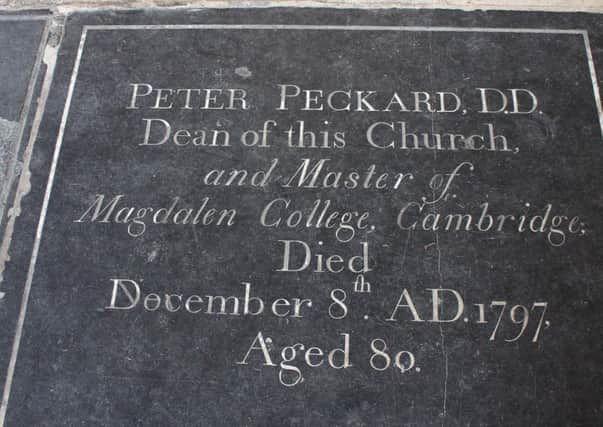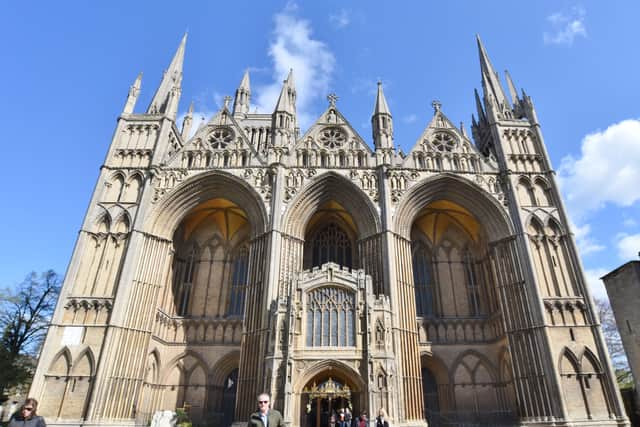Plans to more fully recognise Peterborough’s anti-slavery campaigner


After removal by protestors of the controversial statue of former merchant and slave trader Edward Colston in Bristol, questions are being raised about other statues and street names of prominent figures in towns and cities related to Britain’s slaving past.
Since Covid-19 lockdown closed its doors to the public, Peterborough Cathedral has been running a series of fascinating online ‘Tales from Tour Guides’ on aspects of its architecture, treasures and history by its regular volunter tour guides. The latest has been on former Dean Peter Peckard, who is widely known as the ‘Father of the Abolition Movement’ who inspired the likes of William Wilberforce and Thomas Clarkson with his sermons and pamphlets to bring about an end to the British slave trade.
Advertisement
Advertisement
He is buried in the New Building at the east end of the cathedral under a grey slab simply stating ‘Peter Peckard, Dean of this Church and Master of Magdalen College, Cambridge. Died December 8th 1797 Aged 80’.


Now there are plans to mark his role in history more significantly in a positive response to the debate about statues.
Liz Hurst, Communications Manager at the cathedral said: “Peterborough Cathedral is proud that Peter Peckard was one of the early proponents of the abolition of the slave trade and published the pamphlet entitled ‘Am I not a man and a brother?’ which was to become a rallying call for the movement.”
The cathedral has initiated an annual Peckard Lecture (postponed this year) intended to focus on issues of social justice that were so important to him.
Advertisement
Advertisement
She added: “Active consideration is being given to how we can enhance the interpretation near to his grave stone, highlighting both his importance and the issues he addressed.”
Liz said that Peter Peckard’s story was due to be published this week already, but added: “It certainly shines a light on Peterborough’s little known connection with the anti-slavery movement when there is so much interest in this aspect of our history.”
Dr Rowan Williams, Master of Magdalene College Cambridge and former Archbishop of Canterbury, gave a talk on the work of Peter Peckard and its relevance to today’s society when he visited the city two years ago.
Peckard’s life spanned much of the 18th century. Born in Welbourn, near Sleaford, he served as a military chaplain for the Grenadier Guards in Germany and was a fellow of Corpus Christi College in Oxford and then Master of Magdalene College, Cambridge.
Advertisement
Advertisement
In the 1770s he wrote a series of influential sermons and pamphlets including the anonymously entitled ‘Am I not a Man and a Brother?’ on the arguments against the evils of slavery.
The title and image on its front page became iconic and even used on china produced by Josiah Wedgewood promoting the anti-slavery cause.
He became concerned after the reports of a slave ship in the Caribbean whose captain threw overboard approximately 130 slaves. Despite widespread horror in England, the captain was not prosecuted, as slaves were equated to livestock.
Peckard became Vice Chancellor of Cambridge University three years later and set a prize essay title for students to attempt on the topic, “Is it lawful to enslave human beings against their will?”
Advertisement
Advertisement
Young student Thomas Clarkson was declared the winner of the competition, leading to his work to overthrow the evil of slavery in England.
Peckard continued to write on the issue, providing the slogan for the abolitionist movement.
Having served as vicar in parishes around the city, he became Dean of Peterborough Cathedral in 1792 dying five years later, fifteen years before the Slave Trade was outlawed in 1807.
Liz explains the Tales from Tour Guides blog posts are written by some of the volunteers who lead the guided tours at the Cathedral in normal times. All the guides complete a training course learning about the Cathedral’s history. Many of them continue with their own research, developing their knowledge of the cathedral and its story.
Advertisement
Advertisement
She said: “The blog started just after we went into lockdown. It has been a great way of keeping in touch with our volunteer guides and letting them share their own favourite themes, but at the same time it has provided lots of fascinating content for our social media. This helps us to engage with regular, as well as potential new visitors.
“We hope that people will have learned just enough to want to visit the cathedral when that is possible once again.”
She said it had been wonderful to see how the range and variety of the topics has tapped into current affairs.
“We posted our blog about First World War nurse Edith Cavell on International Nurses’ Day, and first-hand stories about fire watchers during the Second World War on VE Day.
Advertisement
Advertisement
“The blog is providing us with an interesting set of snapshots of the cathedral’s history, which will be useful to refer to in the future.”
They expect to bring the series to a close at the end of June, as preparations are made to gradually re-open the cathedral – although it is not yet clear when tours will be able to resume.
Visit the Tales from Tour Guides here.